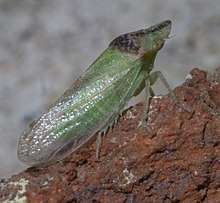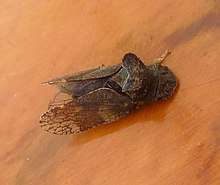Ledrinae
Ledrinae is a relatively small subfamily within the very large and diverse leafhopper family Cicadellidae. Originally placed in its own family, the "Ledridae",[1] it is based on the type genus Ledra.
| Ledrinae | |
|---|---|
 | |
| A nymph from southern India showing the typical form | |
| Scientific classification | |
| Kingdom: | Animalia |
| Phylum: | Arthropoda |
| Class: | Insecta |
| Order: | Hemiptera |
| Infraorder: | Cicadomorpha |
| Superfamily: | Membracoidea |
| Family: | Cicadellidae |
| Subfamily: | Ledrinae (Kirschbaum, 1867) |
Description
The Ledrinae are mostly green or brown with a flattened body and tibiae. The ocelli are located near the crown and the forewings have a dense network of veins.
Tribes and Genera
The subfamily contains around 500 species which are divided into 5 to 7 tribes depending on the taxonomy followed. A 2009 revision treats the subfamily as having five tribes. The Afrorubrini are found only in southern Africa with 2 genera; the Hespenedrini has a single genus in Chile; Rubrini with a single genus in Australia; and two larger tribes that have a more widespread distribution, especially the Ledrini. Altogether there are more than 40 genera and around 14 others which are not well-placed.[2]
Genera considered members of the subfamily Ledrinae are listed below; Biolib.cz[3] currently lists seven tribes.
Afrorubrini
An African tribe, created by Jones in 2009 and consist of two genera:[4]
- Afrorubria Linnavuori, 1972 c g
- Sichaea Stål, 1866
Ledrini
The largest tribe (including Petalocephalini[2]), in number of genera, was originally erected by Fairmaire in 1855 and includes the following genera:[5]
- Bascarrhinus Fowler, 1898 c g
- Beniledra Linnavuori, 1972 c g
- Betsileonas Kirkaldy, 1903 c g
- Camptelasmus Spinola, 1850
- Chatura Distant, 1908
- Cololedra Evans, 1969
- Confucius Distant, 1907
- Destinia Nast, 1952
- Destinoides Cai & He, 2000
- Dusuna Distant, 1907
- Eleazara Distant, 1908
- Eogypona Kirkaldy, 1901
- Epiclinata Metcalf, 1952
- Ezrana Distant, 1908
- Funkikonia Katô, 1931
- Hangklipia Linnavuori, 1972
- Hemipeltis Spinola, 1850
- Jukaruka Distant, 1907
- Latycephala McKamey, 2006
- Ledra Fabricius, 1803
- Ledracorrhis Evans, 1959
- Ledromorpha Stål, 1864
- Ledropsella Evans, 1966
- Ledropsis White, 1844
- Macrotrichia Zhang, Sun & Dai, 2009
- Midoria Katô, 1931
- Neotituria Kato, 1932
- Pachyledra Schumacher, 1912
- Parapetalocephala Katô, 1931
- Petalocephala Stål, 1854
- Petalocephaloides Kato, 1931
- Platyjassites† Hamilton, 1990
- Platyledra Evans, 1936
- Porcorhinus Goding, 1903
- Stenoledra Evans, 1954
- Thlasia Germar, 1836
- Titiella Bergroth, 1920
- Tituria Stål, 1865
- Turitia Schumacher, 1912
Monotypic Tribes
- Hespenedra Kramer, 1966 (tribe Hespenedrini)
- Rubria Stål, 1865 c g (tribe Rubrini)
Stenocotini
- Anacotis Evans, 1937 c g
- Kyphocotis Kirkaldy, 1906 c g
- Kyphoctella Evans, 1966 c g
- Ledracotis Evans, 1937 c g
- Smicrocotis Kirkaldy, 1906 c g
- Stenocotis Stål, 1854 c g
Thymbrini
This tribe was erected by Evans in 1936; Biolib lists the following genera:[6]
- Alseis Kirkaldy, 1907 c g
- Epipsychidion (insect) Kirkaldy, 1906
- Hackeriana Evans, 1937 c g
- Ledraprora Evans, 1937 c g
- Ledrella Evans, 1937 c g
- Macroceps Signoret, 1879 c g
- Microledrella Evans, 1969 c g
- Mitelloides Evans, 1939 c g
- Novothymbris Evans, 1941 c g
- Platyhynna Berg, 1884 c g
- Putoniessa Kirkaldy, 1907 c g
- Putoniessiella Evans, 1969 c g
- Rhotidoides Evans, 1937 c g
- Rhotidus Walker, 1862 c g
- Putoniessa Kirkaldy, 1907 c g
- Putoniessiella Evans, 1969 c g
- Rhotidoides Evans, 1937 c g
- Rhotidus Walker, 1862 c g
- Stenalsella Evans, 1966 c g
- Thymbrella Evans, 1969 c g
- Thymbris Kirkaldy, 1907 c g
Xerophloeini

This tribe was erected by Oman in 1943; Biolib lists five genera:[7]
- Pariacaca Szwedo, 2002 c g
- Piezauchenia Spinola, 1850 c g
- Proranus Spinola, 1850 c g
- Xedreota c g
- Xerophloea Germar, 1839 c g b
Data sources: i = ITIS,[8] c = Catalogue of Life,[9] g = GBIF,[10] b = Bugguide.net[11]
Note: Platyhynna Berg, 1884 c g is now placed in the tribe Hyalojassini (in the family Cicadellidae).
Gallery
References
- Kirschbaum (1867) Jahrb. nassau. Ver. Naturk., 21/22: 14; in: Melville RV, Smith JDD (1987)
- Jones, J. R.; Deitz, L. L. (2009). "Phylogeny and systematics of the leafhopper subfamily Ledrinae (Hemiptera: Cicadellidae)" (PDF). Zootaxa. 2186: 1–120.
- "biolib.cz, subfamily Ledrinae". Retrieved 21 February 2020.
- Biolib.cz: tribus Afrorubrini Jones, 2009 (retrieved 21 February 2020)
- Biolib.cz: tribus Ledrini Fairmaire, 1855 (retrieved 21 February 2020)
- Biolib.cz: tribus Thymbrini Evans, 1936 (retrieved 22 February 2020)
- Biolib.cz: tribus Xerophloeini Oman, 1943 (retrieved 21 February 2020)
- "ITIS, Integrated Taxonomic Information System". Retrieved 2018-05-13.
- "Macrosiphoniella millefolii species details". Catalogue of Life. Retrieved 2018-05-13.
- "Macrosiphoniella millefolii". GBIF. Retrieved 2018-05-13.
- "Macrosiphoniella millefolii Species Information". BugGuide.net. Retrieved 2018-05-13.


